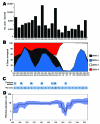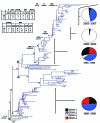Endurance, refuge, and reemergence of dengue virus type 2, Puerto Rico, 1986-2007
- PMID: 21192856
- PMCID: PMC3204641
- DOI: 10.3201/eid1701.100961
Endurance, refuge, and reemergence of dengue virus type 2, Puerto Rico, 1986-2007
Abstract
To study the evolution of dengue virus (DENV) serotype 2 in Puerto Rico, we examined the genetic composition and diversity of 160 DENV-2 genomes obtained through 22 consecutive years of sampling. A clade replacement took place in 1994-1997 during a period of high incidence of autochthonous DENV-2 and frequent, short-lived reintroductions of foreign DENV-2. This unique clade replacement was complete just before DENV-3 emerged. By temporally and geographically defining DENV-2 lineages, we describe a refuge of this virus through 4 years of low genome diversity. Our analyses may explain the long-term endurance of DENV-2 despite great epidemiologic changes in disease incidence and serotype distribution.
Figures






References
-
- Gubler DJ. Dengue/dengue haemorrhagic fever: history and current status. Novartis Found Symp. 2006;277:3–16; discussion 1622, 71–3, 251–3. - PubMed
-
- Dietz V, Gubler DJ, Ortiz S, Kuno G, Casta-Velez A, Sather GE, et al. The 1986 dengue and dengue hemorrhagic fever epidemic in Puerto Rico: epidemiologic and clinical observations. P R Health Sci J. 1996;15:201–10. - PubMed
-
- Rigau-Pérez JG, Vorndam AV, Clark GG. The dengue and dengue hemorrhagic fever epidemic in Puerto Rico, 1994–1995. Am J Trop Med Hyg. 2001;64:67–74. - PubMed
-
- Rigau-Pérez JG, Ayala-Lopez A, Garcia-Rivera EJ, Hudson SM, Vorndam V, Reiter P, et al. The reappearance of dengue-3 and a subsequent dengue-4 and dengue-1 epidemic in Puerto Rico in 1998. Am J Trop Med Hyg. 2002;67:355–62. - PubMed
Publication types
MeSH terms
Grants and funding
LinkOut - more resources
Full Text Sources
Medical
